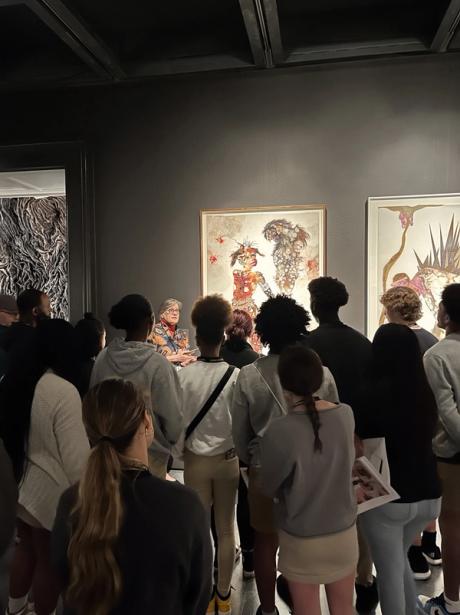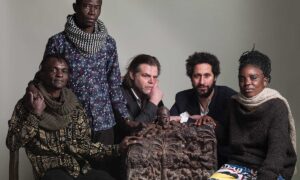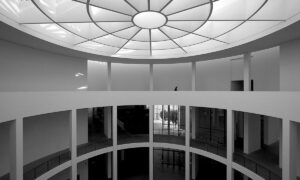
Amid the US culture wars and a heated 2024 presidential election season, a Louisiana art museum has invited students to learn about African American history through contemporary art.In February and March, more than 225 secondary-school students from across the state participated in workshops at the New Orleans Museum of Art (Noma) in conjunction with the exhibition by the Kenyan American artist Wangechi Mutu, Intertwined (until 14 July). Teachers and students of African American studies and art history travelled to Noma from five schools as far away as Baton Rouge to connect terminology learned in their classes, such as Afrofuturism, with Mutu’s works.Students are not just taking the courses on a whim. These Advanced Placement (AP) classes are high-level courses that US students can use towards university credit. AP courses are available to secondary-school students in a variety of subjects: English language and literature, biology, calculus and art history, among others. The AP African American Studies course is among the newest additions to the AP programme—now in its second year after much hand-wringing among Republicans, specifically in Florida, as to the need for the subject.As for AP Art History, one of Mutu’s collages, Preying Mantra (2006), is included in the 250 works that make up its curriculum; although the work is not part of Intertwined, students were able to experience some of the artist’s similar pieces firsthand at Noma.The lens of AfrofuturismIn addition to a tour of Mutu’s exhibition, the Noma curators Lisa Rotondo-McCord and Amanda M. Maples gave students and teachers walkthroughs of the museum’s African art collection. The curators contextualised Mutu’s work through the art-historical lens of Afrofuturism, which merges science fiction, posthumanism, protofeminism and environmental studies to construct a historical lineage—from the African diaspora to contemporary Black art and literature—and imagines a utopian future for people of colour.As part of the programme, Mutu herself engaged directly with student questions and talked about her inspirations and artistic practice, joining the group in a virtual conversation from her studio in Nairobi. Students also attended a “seated lesson”, which discussed Mutu’s career, her influences, “what was going on in the art world when she started working in the 1990s, Preying Mantra and the methodology of Afrofuturism”, Kristin DiGioia, the education programmes manager at Noma, tells The Art Newspaper.“I was proud to lead the lessons,” adds DiGioia, who came up with the initial idea for the workshops, as she was previously an AP teacher herself and aware that Mutu’s art was part of the AP Art History curriculum. “The energy was contagious. The students were clapping for each other after they made comments, and they were inspired by what they were saying to each other. Mutu’s work is sophisticated and complicated, and it addresses and interrogates a lot of high-level themes. They hung in there for that, supported it and engaged with it, and that’s college-level work.”The curriculum was developed by Noma’s Learning and Engagement Department, responsible for creating resources for teachers, encouraging informal learning at the museum and organising public programmes. “When we discussed programming for this exhibition, our entire team was at the table, so we had a broader discussion about how to do it,” says Redell Hearn, Noma’s chief educator. “We asked the artist what she was interested in having the takeaway be for this community at large in New Orleans. And for every aspect of it, she wanted it to be as accessible as possible to all people in the community. That accessibility factor was a main part of it. The other was this age group—young people—that was something she was very interested in.”Previous allegations of institutional racismThe student workshops follow major restructuring efforts at Noma, initiated in response to the Dismantle Noma movement, formed by a group of former employees in 2020 who alleged a culture of institutional racism and discrimination at the museum. The group’s criticisms were raised against the backdrop of wider discussions in the US about curatorial practices, museum policies and institutional norms prompted by the resurgence of the Black Lives Matter movement following the murder of George Floyd by police officers in Minneapolis. (Though Noma staff declined to respond to questions about whether this programming was undertaken to address criticisms of the museum, since Dismantle Noma’s accusations were made public, Noma has made an effort to educate and diversify its staff and board, bring in more work by artists of colour and integrate feedback from the local community.)The new AP African American Studies programme follows a surge in interest in Black studies stemming from this same moment in 2020, by those both in favour and against adding Black history to school curricula nationwide.Baton Rouge Magnet High School (BRMHS), which participated in the Noma workshops, was one of the first to test the AP African American Studies programme. BRMHS teacher Emmitt Glynn, who accompanied his students to Noma, led one of 60 pilot courses in the US in 2022. Now, almost 700 schools across the country are participating in the pilot programme’s second year; this autumn, AP African American Studies will officially open to all US schools.This effort comes as an antidote to the culture wars surrounding education in conservative states in recent years, which have banned teaching critical race theory as well as The New York Times Magazine’s 1619 Project, which in 2019 commemorated the 400th anniversary of the arrival of the first slave ship in Virginia and aims to recontextualise foundational events in US history from a Black perspective. Last year, Florida governor Ron DeSantis banned AP African American Studies from his state, and Louisiana’s new governor, Jeff Landry, has pledged to prevent “the latest radical social cause” from “indoctrinating” schoolchildren in his own state.Regardless of all this political grandstanding, Glynn’s students are responding well to their course materials. Glynn has found that AP African American Studies prepares them for college-level coursework, developing their critical-thinking skills and educating them about aspects of US history that they might not have otherwise known, while facilitating interesting discussions with their families at home. “I have had parents on parents’ night after just a few weeks of their kids being in the course tell me, ‘You would be amazed at the conversation at the dinner table now,’” Glynn says.At Noma, Glynn liked that Maples “explained to us about the way that women are portrayed in African art—the way they are venerated in African society, because they bring life”. He was able to connect this and other insights at the museum both with his lessons—on colonialism, the African diaspora, Afrofuturism, Négritude and Negrismo—and with Mutu’s work. “It was phenomenal,” he says. “The students and I were mesmerised by each piece. I’ve been a teacher for over 30 years and gone on many field trips. That was one of the best field-trip experiences I have ever experienced with a group of students. It resonated in so many different ways.”
























